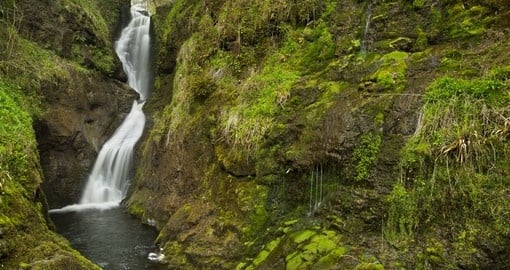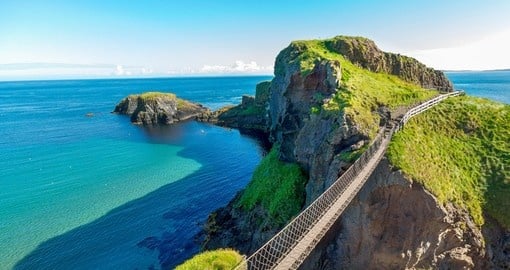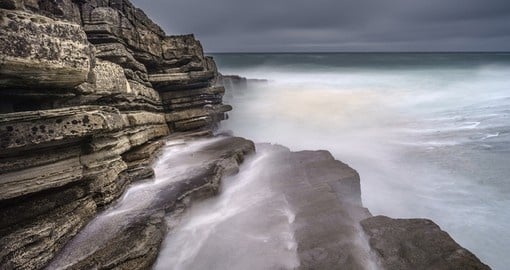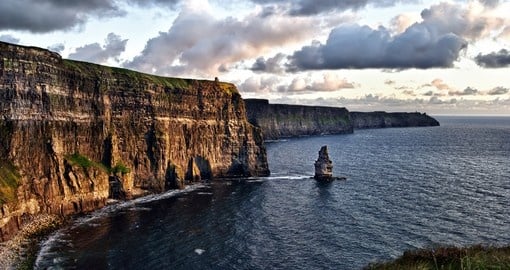Walking the Greenways of Ireland
Welcome to Ireland
Welcome to Dublin. On arrival we are met by our driver and guide and after a brief orientation tour of the city we depart for the Antrim Coast and our hotel. Tonight we enjoy a Welcome dinner at a local restaurant.
Accommodation: Glens Hotel or similar
| Meal Plan | Dinner |
|---|---|
| Duration | 4 Nights |
Slemish Mountain and Glenariff Forest Park
Today enjoy a day of hiking/walking at Slemish Mountain and Glenariff Forest Park
Slemish Mountain
Slemish Mountain, the legendary first known Irish home of Saint Patrick, is located in Co. Antrim. The mountain rises about 1500 feet (437 metres) above the surrounding plain, and it is actually the central core of an extinct volcano. According to legend, following his capture and being brought as a slave to Ireland, Patrick worked as a shepherd at Slemish Mountain for about six years, from ages 16 through 22, for a man named Milchu (or Miluic).
Enjoy a walk at Slemish Mountain. The walk starts from the car park up a steep rocky track to the summit some 1437 feet above sea level. The track down is much gentler and leads back to the car park. This is a short walk of 1.2 miles (Please allow approximately 30 minutes for this walk)
Continue to Glenariff Forest Park where you will enjoy some free time for walking
Glenariff Forest Park is situated amid the world famous Glens of Antrim, an area to which tourists have been coming for over a century. Glenariff, the Queen of the Glens, is considered by many people to be the most beautiful of the nine Antrim Glens. The Park, now including the former Parkmore Forest, covers an area of 1185 ha of which 900 ha have been planted with trees. The remainder consists of several small lakes, recreation areas and open space left for landscape and conservation reasons. The Forest is open every day of the year from 10:00 am until sunset.
Return to our hotel on the Antrim Coast
| Meal Plan | Breakfast |
|---|
Giants Causeway and Carrick-a-Rede Rope Bridge
Travel along the coast of county Antrim to the Giants Causeway.
Visit the Giants Causeway
The Causeway was formed more than 60 million years ago when red-hot lava erupted onto the surface of the earth. It was quickly cooled by the sea, which crystallised it and formed it into the 40,000 basalt polygonal columns, which today form the Giants Causeway. A must on any visit to the North of Ireland, the Causeway is an UNESCO World Heritage site, and is often referred to as the 'Eighth Wonder of the World’. There is a bus service from the heritage centre to the Causeway (a charge applies).
Here the group can enjoy a walk/hike along the North Antrim Cliff Path to Dunluce Castle.
This well maintained walkway follows a key section of the longer Causeway Coast Way & Ulster Way. Nearly 5 miles in length, this section of coast from Giant’s Causeway to Dunluce Castle is officially referred to as the North Antrim Cliff Path (& maintained by The National Trust). The spectacular cliff landscape & rich biodiversity of the coast merges effortlessly with the surrounding farmland, where grazing cattle and sheep are common place. And it is this mix of conservation & working farm practices which have created rich mosaics of wild habitats for birds, plants & insects. And the built heritage is note worthy, with the promontory fort & later stone castle of Dunseverick Castle being an added interest. (Please allow approximately 2 hours for this walk)
Pick up by coach at Dunluce Castle and continue to Carrick-a-Rede Rope Bridge.
Visit Carrick-a-Rede Rope Bridge
Carrick-a-Rede, on the Antrim Coast, is a spectacular rope bridge, which spans a chasm some eighty feet deep. Primarily a seasonal working bridge for fishermen, it connects a small island to the mainland. Its construction once consisted of a single rope handrail and widely spaced slats, which the fishermen would cross to bring ashore salmon caught off the island. The single handrail was subsequently replaced by today’s two-handed railed bridge. Although no one has ever been injured falling off the old bridge, there have been many instances of visitors being unable to face the return journey across the bridge, resulting in the return journey being made by boat. Underneath the bridge are large caves, which often served as a safe haven for fishing trawlers escaping from winter storms.
| Meal Plan | Breakfast |
|---|
Rathlin Island
This morning depart for Rathlin Island by ferry.
A rare place, wild, beautiful and of extraordinary ecological value and social interest. This island lies 9 kms off Ballycastle in the north-east of Ireland and 24 kms from the Mull of Kintyre in Scotland. It is 12 kms long and less than 1½ kms wide. The island is surrounded by limestone and basalt sea cliffs reaching 470 ft in places. Three lighthouses stand as monument to its wild coast while over 40 recorded shipwrecks which lie off its coasts. The islands houses one of Ireland largest seabird colonies and visitors may visit the island during May to September by availing of the boat service Ballycastle port. The current population on the island is 110 persons ~ old & young.
Enjoy a 4 mile (6.4km) walk on Rathlin Island which will lead you from the harbour to the Seabird Centre located by the West Lighthouse. After an initial steep section out of the village, it is a fairly gentle walk on an almost traffic-free road. (Please allow approximately 2 hours for this walk)
Enjoy lunch on the Island and visit the Sea Bird Centre, where puffins, guillemots, razorbills and kittiwakes can be viewed during the summer months. From here, on clear days, Donegal, the North Antrim coastline, the island of Islay and the Mull of Kintyre can be seen
Return to the mainland where the balance of the day is at leisure.
| Meal Plan | Breakfast and Lunch |
|---|
Derry & Donegal
This morning travel to Derry.
Meet with a local guide for a guided walking tour of Derry.
Founded in the 6th century by St Columba, Derry is the second largest city and port of Northern Ireland. Columba named it “Doire” or “Oak grove” which was later anglicised as Derry. In 1613 the city was selected as a major plantation project, organised by the London livery companies, and as a result it acquired the prefix London. In the same year the walls of Derry were built to protect the town from the Gaelic chieftains in Donegal. A walk on the walls is a must on any visit to Derry as they are among the best-preserved fortifications in Europe. Rising to a height of 8m they are 9m wide in some areas. Today these walls separate two communities, the Bogside ~ a Catholic getto with its famous murals and the Waterside ~ a Protestant enclave.
Continue to Co. Donegal and to Glenveagh National Park
Situated in northwest Donegal, the core area of Glenveagh National Park was formerly an enormous private estate of over 9,500 hectares in extent. The present day National Park now includes elements of another large estate and has a total area of over 16,500 hectares, making it Ireland's largest. It boasts, like Killarney, beautiful lakes set in impressive mountain scenery (the Park includes the two highest peaks in Donegal - Errigal and Slieve Snacht). The underlying granite gives to the landscape a quite different character to the sandstone and limestone strata of Killarney however. At the south-west end of the Park are the ice-carved cliffs of the Poisoned Glen and Bingorm, while the north-east end has a gentler array of hills, deep peat bogs and the swampy valley of the Owencarrow River.
On arrival at Glenveagh Visitor Centre depart for a walk along Lough Beag to Glenveagh Castle
The castle built by John George Adair in 1870 and was modeled on Balmoral (Royal Castle in Scotland) in miniature. Over 420 Irish families were evicted by Adair to form the estate ~ an event, which lead to a curse being put on all the owners of Glenveagh Castle by an old lady who was evicted from her tiny cottage. As a result of the curse no children were ever born to any of the 3 owners of the castle. Henry McIlhenny (its last owner) restored the castle as a comfortable gentleman’s home with many reminders of the deer hunting once so important to upper class society life. The castle received many visitors in its time ~ some of the most notable being Greta Gabor and Princess Grace of Monaco. (This walk will take approximately 1 hour to complete)
Enjoy some free time to explore some of the walking tracks at the park.
Continue to Dunfanaghy
Accommodation: Arnolds Hotel
| Meal Plan | Breakfast |
|---|
Donegal
Its location in the Northwest of Ireland has kept Donegal secret and wild. The Irish consider it to be the most beautiful county In Ireland because of the great diversity of scenery. Donegal is formed by coastal scenery, mountains, lakes and bogs covered in heather ~ all of which combine to give it a unique charm. Its roads are narrow and will lead you to tranquil and deep bays, long deserted beaches inhabited only by the sea birds and high cliffs and a coastline dotted with small islands. The narrow winding roads force you to take your time and allow you to enjoy the wild and unspoiled nature.
Continue along the Donegal Coast enjoying views of Slieve League. Here you will enjoy a hike to the famous cliffs. The Slieve League (Grey Mountain) cliffs, situated on the West coast of Donegal, are said to be the highest and one of the finest marine cliffs in Europe with a three hundred metre drop straight down into the wild, Atlantic waves below. This creates a breathtaking but extremely scary view. However, there is much more to see besides the cliffs. There are terrific views of the sea and the Sligo Mountains to be seen. Donegal Bay can be clearly seen as you walk towards the terrifyingly high top of Slieve League and there is a small lake at eye level. A short walk will take you to the right of the amazing cliff face of Bunglas (which literally means end of the cliff) which rises over 306m above the raging ocean. One Man's Path will take you to the summit of Slieve League but the climb must be approached with extreme caution as it is very dangerous.
Please allow approximately 2 hours for this walk
Continue along the coast past towns such as Kilcar and Killybegs before reaching Bundoran.
Accommodation: Great Northern Hotel
| Meal Plan | Breakfast |
|---|---|
| Duration | 1 Night |
Bundoran to Galway
This morning travel to Galway City where you will enjoy a walking tour with your guide
Galway City at the mouth of Galway Bay is both a picturesque and lively city with a wonderful avant-garde culture. The city has many relics of its medieval past and is worth taking time to explore. It has changed considerably over the last number of years and features a fascinating juxtaposition of new and ancient architecture. The centre of the city is conveniently compact enough to ramble around comfortably.
Visit Galway Cathedral
The Cathedral is one of the largest and most impressive buildings in Galway City. Built between 1958 and 1965, it stands on the site of the old city jail. The architecture of the Cathedral draws on many influences. The dome and pillars reflect a Renaissance style. Other features, including the rose windows and mosaics, echo the broad tradition of Christian art. The Cathedral dome, at a height of 145 ft, is a prominent landmark on the city skyline. Cardinal Richard Cushing of Boston dedicated the cathedral in 1965. The exterior design may not be to everybody’s taste, while the interior, with its high curved arches and central dome, has a simple but solid elegance.
Accommodation: Jury’s Inn
| Meal Plan | Breakfast |
|---|---|
| Duration | 2 Nights |
Connemara
This morning enjoy a tour of the Connemara Region.
Connemara is a land of lakes and rivers, bogs and mountains. A land of small villages where Gaelic is still the spoken language and where little has changed little since the beginning of time. It is without a doubt the wildest and the most romantic part of Ireland. Connemara is a vast peninsula bordered by the arid and rocky coastline of Galway Bay in the south ~ a land characteristic for its stone walls and thatched cottages. On its northern shore the land is harsher and more secret, with spectacular views of the Ocean and the beautiful fjord of Killary Harbour, as well as the steep mountains overlooking numerous lakes and large bog areas. Connemara is a real paradise for Nature lovers and those in search of strong emotions.
Transfer to Connemara National Park and enjoy a hike on the Upper Diamond Hill Trail
The hike will last around 2.5 - 3 hours and has a total length of 7 km (4.35 miles) and it is classified as a Level 2. The Upper Diamond Hill trail switches its way through a rugged white-quartzite landscape, ascending to the summit of Diamond Hill (Ascent: 442m), where one is rewarded with expansive panoramic vistas across all of Connemara, the Twelve Ben mountains to the North and East, far down below Kylemore Abbey and Lough, Tully Mountain to the West, and to the North the summit of Mweelrea, Connaughts highest mountain.
In the afternoon enjoy a visit to Kylemore Abbey
Kylemore Abbey is located in the Kylemore Pass in Connemara. Mitchell Henry built the House in 1868, after having spent his honeymoon in the area. The architecture is best described as neo-gothic and the house still displays all the characteristics of that period. One of Kylemore Abbey's most famous features is its miniature cathedral, built in 1870 and known locally as the Gothic church. Today, the abbey is home to the Irish order of Benedictine nuns. They established a private school for young girls, which was the renowned Kylemore Abbey International School. The school eventually closed in 2010. Facilities at Kylemore include a visitor centre, an exhibition housed in the main reception rooms of the house and a video which takes the visitor through the history of the house and its occupants. The Gothic church is available to visit and as a venue for choir groups to sing in. If time allows guests can also visit the Kylemore Abbey Victorian Walled Garden was laid out in 1867 and took three years to complete.
| Meal Plan | Breakfast |
|---|
Burren & Cliffs of Moher
After your full Irish breakfast you will depart for Ballyvaughan in the Burren Region.
The Burren, part of which forms the 100 square km Burren National Park, is a unique place. It is a Karst limestone region of approximately 300 sq. km, which lies in the north-west corner of Co Clare. It is composed of limestone pavements, which have been eroded to a distinctive pattern. This pavement is criss-crossed by cracks known as grykes in which grow a myriad of wild flora and under which are huge caves and rivers which suddenly flood when it rains. The Burren contains dozens of megalithic tombs and Celtic crosses as well as a ruined Cistercian Abbey dating back to the 12th century. The Burren is truly an exceptional part of Ireland.
Transfer to Ballyvaughan for your Wood Loop Walk through the Burren.
The loop offers an 8km (4.97 miles) long walk with a mixture of cross country, minor roads and green roads on a relatively flat ground on the outskirts of Ballyvaughan village. The walk will last 2-2.5 hours and has a moderate level. Opposite the Burren Way and Wood Loop mapboard (by the seafront), takes the minor road to the school and football field. Follow the signs through a stile, and cross county through limestone and woodland areas, (note the follow purple arrows, Burren Way (yellow arrows) also on the start of this loop). Take care crossing the N69, where the loop again takes minor roads, farmland, a lovely short green road and then minor road back to the village of Ballyvaughan.
Visit the Cliffs of Moher
Situated on the Atlantic Ocean and bordering the Burren Area, the Cliffs of Moher are one of Ireland's most spectacular sights. Standing 230 metres above the ground at their highest point and 8km long, the Cliffs boast one of the most amazing views in Ireland. On a clear day, the Aran Islands are visible in Galway Bay as well as the valleys and hills of Connemara. The cliffs reach their highest point just north of O' Brien's Tower built by Cornelius O’ Brien, a descendant of Brian Boru, to entertain his lady friends. The Atlantic Edge is the exciting new interpretive centre at the Cliffs of Moher and is built into the natural landscape. The centre is a huge domed cave that contains images, exhibits, displays & experiences exploring different elements of the mighty Cliffs of Moher: Ocean, Rock, Nature and Man.
| Meal Plan | Breakfast |
|---|
Dingle Peninsula
Enjoy your full Irish breakfast this morning and depart for a walk on the Dingle Peninsula.
Some of the finest coastal scenery to be seen in Ireland can be found in West Kerry, on the Dingle Peninsula, the most northern of the Kerry Peninsulas. This peninsula is famous for its Celtic, pre-Christian monuments and Christian churches. It is also a ‘Gaeltacht' (Irish speaking) area, where the Irish language and traditional ways of life are preserved. Dingle town itself is a thriving fishing town and offers plenty of opportunity for shopping or simply savouring the atmosphere of a typical country Irish town with its plentiful pubs, narrow streets and busy harbour.
Continue for your Cosán Cuas Na Neighe Walk near Dunquin in the west of the Dingle Peninsula
On this 2.8kms (1.74 miles) long walk you can expect sea views, a view of the Three Sisters and the Brandon Mountain range. The estimated time for the walk will be around one hour and the classification for the walk is moderate. You can neither start/finish from/at Trá Cloichear or Clogher Beach near Ballyferriter. Leave now Trá Cloichear / Clogher Beach car park by access road, turn left through kissing gate and follow edges of fields around to turn right back to car park. Loop waymarked with blue arrows on white background.
Accommodation: hosted B&B in Dingle area.
| Meal Plan | Breakfast and Dinner |
|---|---|
| Duration | 1 Night |
Dingle to Dublin via Blarney Castle
After your full Irish breakfast this morning depart for Dublin.
On your way north visit the Blarney Castle
Attracting visitors from all over the world, Blarney Castle is situated in Blarney village, 8 km from Cork City. An ancient stronghold of the McCarthy's, Lords of Muskerry, it is one of Ireland's oldest and most historic castles, and indeed one of the strongest fortresses in Munster. Built in 1446, Blarney Castle is famous for its Blarney stone, The Stone of Eloquence, which is traditionally believed, to have the power to bestow the gift of eloquence on all those who kiss it. Many legends tell the story of the Stone, but why not kiss it and find out the truth behind the legend. The Castle gardens covering 60 acres of land are under constant change and over the past few years, a water garden, fern garden and poison garden have been developed and are all open to visitors. Spend some time at the Blarney Woollen Mills for some personal shopping, it is perhaps the largest quality craft shop in Ireland.
Continue to Dublin and check in to your hotel.
Accommodation: Jury’s Inn
| Meal Plan | Breakfast |
|---|---|
| Duration | 2 Nights |
Dublin’ Fair City
This morning enjoy your full Irish breakfast and explore the capital of Ireland.
Enjoy a Walking Tour of Dublin City Centre with Pat Liddy (subject to availability)
Dublin, while being the Capital city of Ireland housing over 25% of the Republics population, has remained small and compact and an exciting city to visit. It has retained many of its smaller streets and old buildings and indeed many of these buildings are open to the public. A walking tour of Dublin with well-known Artist, author and guide Paddy Liddy is perhaps the best way to visit the capital. While your tour can be adapted to your particular programme it will normally include visits to Medieval and Georgian Dublin ~ two periods that had most influence on the city. Literary Dublin is important and included as is Dublin of today. No visit of Dublin would be complete without a visit to the Dockland Development ~ Dublin’s latest development. The walking tour will normally last 1½ hours but this of course if flexible and will be adapted to the route and your time available. It is limited to 25 pax per tour.
Visit Trinity College & the book of Kells
Thomas Burgh built the Old Library building in the 18th century. Today it houses one of Ireland’s most illustrious books, the 9th century “Book of Kells”. Before viewing the famous book you will pass through an excellent exhibition based on the book of Kells and other important books written in monasteries around Ireland from the 9th century. After viewing the book of Kells you are invited to visit the long room built in 1745. Once the principal library of the University, it now contains over two hundred thousand books and manuscripts of the Trinity’s oldest volumes. Brian Boru’s harp said to be the “oldest harp in Ireland” and a copy of the 1916 proclamation, one of the most important documents relating to Irish history are also on display in the long room.
Continue to the Guinness Storehouse
The Guinness Brewery in Dublin is Europe's largest stout producing brewery and home to the Guinness Storehouse. Opened in 1904, the Storehouse was an operational plant for fermenting and storing Guinness. Today it houses a very fine exhibition dedicated to the Guinness story. You will discover what goes into the making a pint of Guinness - the ingredients, the brewing process, the time, the craft and the passion. The exhibition shows how the brew has been marketed and how it is today sold in over 150 countries. Once the tour has finished your group is invited to the Gravity Bar to enjoy their pint of Guinness. Regular demonstrations on the art of pulling a pint of Guinness also take place in the Storehouse. Launched on the fifth floor in 2011, “Five” at Guinness Storehouse, includes a small replica authentic Irish Bar, an 18th Century inspired Brewers Dining Hall, and a restaurant named Gilroy’s where guests enjoy a Guinness gastronomical experience driven entirely by the Irish tradition of wholesome local produce. Menus include local foods such as Ardsallagh goat’s cheese, Irish mussels from Carlingford and the Waterford Blaas bread supplied by MD Bakery in Waterford.
Enjoy a Farewell Dinner and Entertainment at the Merry Ploughboys Pub
Merry Ploughboys Traditional Nights are a highly entertaining performance of live traditional Irish Music, Song and Irish Dancing. From start to finish, this is a show based on a living and real traditional culture and fantastic interaction between performers and the audience. But first you will enjoy the banquet from the restaurant. After the dancing, the musicians re-take the stage and really up the tempo for the final part of the evening. A night of authentically Irish entertainment is guaranteed. A strong heart is required however, as both musicians and dancers involve the entire audience in this electric performance.
| Meal Plan | Breakfast and Dinner |
|---|
Depart for hometown
After a final farewell breakfast at your hotel depart for Dublin Airport for your return flight home.
| Meal Plan | Breakfast |
|---|
Get a Trip Quote Order a Brochure




















